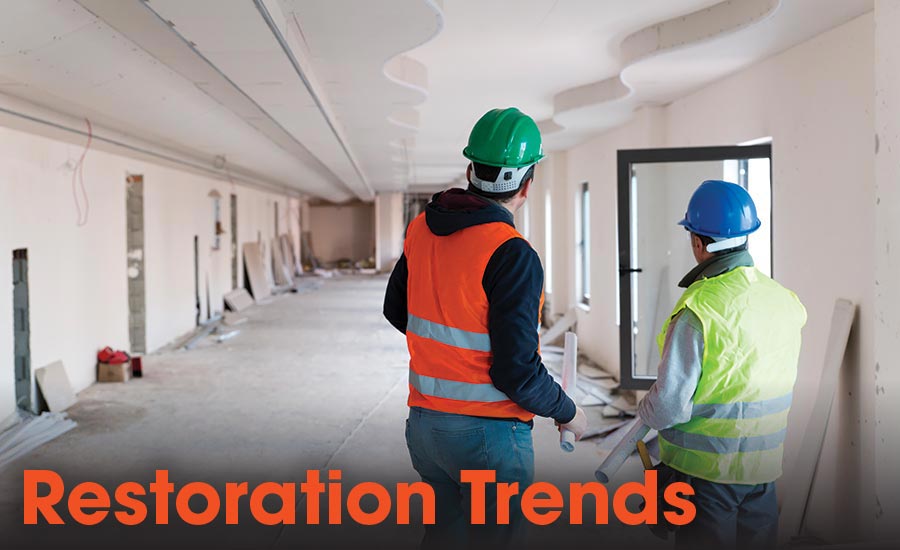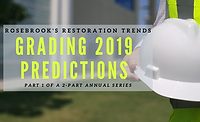Restoration Trends
A look back at 2018 predictions.

Editor’s Note:
This is the first of a two-part series from Phil Rosebrook of Business Mentors. In part 1, Phil will look back at his predictions for 2018 and see how his predictions played out. So, keep in mind as you read his predictions, these were written in late 2017/early 2018! In part 2, which will appear in the April issue of R&R, Phil will offer his projections for the restoration industry in 2019. Enjoy!
Welcome to my {mostly} annual restoration trends update. I have spent more than 30 years working in the restoration industry which gives me a relevant perspective on the business of restoration. The following list is meant to help restoration contractors assess their business strategies – and just be an overall interesting read. I believe these issues will be the top drivers of change, not only in 2019, but into the future.
Before revealing my 2019 predictions, it is appropriate to assess my past predictions from 2018 to provide credibility for my look into the future. Overall, I think that I was very timely on big issues that impacted your business, and our industry in 2018. Here’s how it all played out:
Prediction 1: Labor shortages and wage increases.
There are many big changes happening in the industry, but perhaps the biggest limitation to growth is the availability of labor resources to complete the work. This is true of front-line technicians, managers, and subcontractors. There are more people working today, according to The Bureau of Labor Statistics, than any other time in the history or our country. Unemployment was under 4% for most of the year which, according to many economists, is statistically 0. This factor has driven up costs for many companies and limited growth in others.
Grade for this prediction: A
Prediction 2: Industry pricing challenges.
The way our industry prices jobs is creating a stagnant pricing structure and often the feedback program used by many restorers creates downward pricing. At a time where labor and material costs are increasing, the feedback component of the unit cost pricing fails to accurately capture true costs. Some of the feedback challenges are user-based due to lack of understanding on how to update retail jobs or a lack of ownership of these processes. The current pricing structure is making it very difficult to achieve or maintain margins. Even if you are effectively updating pricing, this model is reactive and a lagging indicator of costs.
Grade for this prediction: A
Prediction 3: TPA influence.
There has been a lot of influence on this subject over the past year for several reasons. The first is the substantial increase in the amount of work handled by these programs. The next is the influence of these programs on the job scope. Although the top managers at these programs have an apparent intention to make sure the job is completed with the right scope and for a fair price, this is not always the case. There are many who believe the role of these programs is to minimize the scope at all costs. Others realize it takes additional administrative, management, and frontline resources to meet the program expectations.

Regardless of your thoughts on the programs, you can expect them to continue to affect the insurance restoration market. I also expect these programs to continue to consolidate and also push for stronger compliance. I suspect as new and upcoming programs try to differentiate in the market, they will come up with new and better ways to measure and control the contractors – expect more and faster. I also would expect these programs to extend their reach outside the insurance market and into self-insurance, hospitality, medical and property management work.
Grade for this prediction: A
Prediction 4: Continuing movement of outside groups.
Given the influence of the TPA programs and manipulation of claims by some insurance companies, I see an increased influence of the “outsider” groups that are standing up for the independent company. The programs are gaining traction through social media. I am not certain of their impact or influence in the industry because they are swimming upstream. I don’t want to minimize their potential impact, but I am also uncertain of how long any influence will take.
I don’t think they will have an immediate or strong impact in the industry – but they do have a place. You can see the influence of these types of groups of overthrowing governments around the world – so I would keep an eye on their influence. I also think that at the least they will help the independent companies improve their businesses and process.
Grade for this prediction: B. I see movement in this area, but I don’t think it had a big impact on the industry or individual companies. In fairness, I did state that they would likely have a limited immediate impact. I wonder if change will more likely occur from inside the industry, rather than the outside groups?
Prediction 5: Weather.
The top story of 2017 was the spike in weather events. There were events in nearly every quarter of the year and in nearly every corner of the country in 2017. This was great news if this was in your backyard. Some of the events were so significant many companies hit the road to help for the first time in their history. One challenge was that the every-day claims appeared to be down in many markets. This was quite a dichotomy because peak work was followed by slow times.
I expect the trend of weather events to continue in 2018. In past years, where we had dry weather in the West Coast in the winter and artic air in the Midwest, the hurricane season was very mild. I wonder if we are setting up for that again. The situations that lead to fires in Canada and the West appear to be setting up for a similar situation this year. I would expect large fires to be a factor again along with typical spring rains and windstorms. I am not a meteorologist – but my unprofessional opinion is that we will not see a repeat of the 2017 hurricane season.
Again – not a professional or educated opinion, but it is starting to look like the earthquake potential is picking up throughout the ring of fire and also in other regions of the country. I would not be surprised to see a major – 6.5 or greater earthquake somewhere in the US this year.
Grade for this prediction: A or F. This was an interesting one to grade. I failed in my prediction of limited hurricane activity. I was feeling fairly smart until September when we were hit by Florence and then Michael shortly after. I did feel vindicated when the earthquake hit Alaska in December (not that it was a good thing – just accurate). The A part of this grade comes from the entire prediction other than the hurricane activity.

Prediction 6: Consolidation and M&A activity.
Over the past decade both the restoration and insurance industries have seen a major wave of consolidation. This is coming from outside groups, private equity, growing restoration enterprises, and even publicly traded companies. This is not unique to our industry or even insurance; it is the nature of business. These trends appear to be accelerating as people with money are looking for yield. Acquiring companies and then driving value through efficiencies or increasing earnings multiples through larger EBITA numbers is an effective strategy. Given the strong economy, low yields for bonds or savings, as well as the large influx of cash due to the new tax plan, I expect 2018 to be a strong year for M&A activity – both in our industry and from our client groups.
Grade for this prediction: A
Looking for a reprint of this article?
From high-res PDFs to custom plaques, order your copy today!





